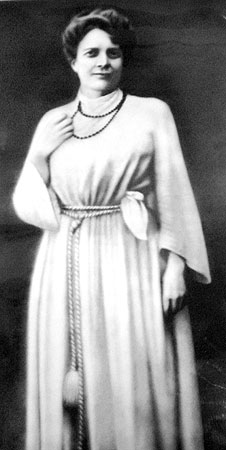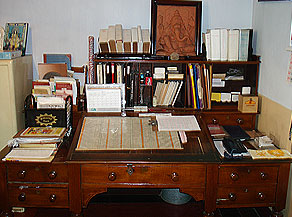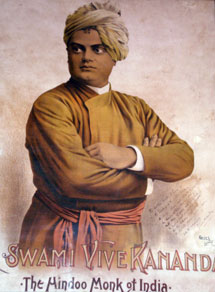 Sister Nivedita Nivedita: the Dedicated One
Sister Nivedita Nivedita: the Dedicated One
Margaret Noble was of Irish parentage and was born at Tyrone, Ireland, on October 28, 1867. Her father Samuel was a priest of an Irish Church, and her mother Mary was a kindhearted young lady. Her grandfather John Noble was also a priest with deep love for God and his motherland. From her grandfather Margaret inherited undaunted courage and vigorous patriotism, while from her father she inherited boundless compassion for the poor. Margaret often went with her grandfather and her father to the homes of the poor and rendered service to them. After finishing. Along with these she possessed a breadth of heart to a remarkable degree.
As a result there was growing dissatisfaction in her with the ways of the then existing orthodox religion and was tormented by doubt and a feeling of uncertainty.It was at this time, that Swami Vivekananda reached London with his message of Vedanta. And his words came as "living water to men perishing of thirst", to quote Margaret's own words.
In March 1899 a plague epidemic broke out in Kolkata. Inspired and guided by Vivekananda, Nivedita plunged into action to save the city. She formed a committee of dedicated workers from among the inspired youth who helped her fight this menace. They cleaned the streets and lanes and nursed the victims. Nivedita worked round the clock, often foregoing food and rest. She often gave up drinking milk to save the money to help others. Her health was seriously impaired as she ran from home to home, hoping against hope to overtake and defeat death. At times, Nivedita stayed on with the bereaved for hours together, offering them her consolation and sympathy. Nivedita and her team incessantly carried on their formidable effort for a full month before they succeeded in controlling the disease.
 Desk of Sister NiveditaNivedita started her school at No.16, Bosepara Lane
in Bagh Bazar, Kolkata on November 13,1898 with the
blessings of Holy Mother. Parents in the Orthodox Indian
society at that time hesitated to send their daughters
to school and more so to a school run by a woman of
an alien culture. Nevertheless Nivedita succeeded in
beginning with a few girls of varying ages. It was extremely
difficult to meet the expenses of the school and have
enough left sustain herself
Desk of Sister NiveditaNivedita started her school at No.16, Bosepara Lane
in Bagh Bazar, Kolkata on November 13,1898 with the
blessings of Holy Mother. Parents in the Orthodox Indian
society at that time hesitated to send their daughters
to school and more so to a school run by a woman of
an alien culture. Nevertheless Nivedita succeeded in
beginning with a few girls of varying ages. It was extremely
difficult to meet the expenses of the school and have
enough left sustain herself
In June 1899, Nivedita went to Europe and America to get financial help for her school in India. She returned in February 1902 and that very year, Swami Viveknanda attained Mahasamadhi. To fulfill his trust she sprang in to action shaking off her grief. Her conviction grew that a nation under foreign domination could not dream of regeneration be it social, political or cultural. She vowed to work for the liberation of the country she had adopted. Nivedita made her school a centre of nationalistic activity where Bankim Chandra’s national anthem, Vande Mataram was the school prayer. She preached that nationalistic sentiment and faith on the ideals of Sri Ramakrishna and Vivekananda would usher in a new dawn of hope. Nivedita's life had become one continuous round of political campaigns, public addresses and writing books.
Her writings and speeches inspired young men to lead nobler and purposeful lives. She was an unfailing source of inspiration to Rabindranatha Tagore and to eminent political leaders like Surendranath Bannerjea, Gopalakrishna Gokhale, Ramesh Chandra Dutta, Bipin Chandra Pal and Aurobindo Ghosh. The political leaders Bal Gangadhar Tilak and Mahatma Gandhi paid their respects to her.
 Nivedita wrote books on Indian cultural heritage. She
encouraged gifted artists like Abanindranath Tagore,Nandalal
Bose and funded their study of the works of art of Ajanta,
Ellora and other great Indian artists of the past. From
1902 to 1904 she went on extensive lecture tours, urging
people to strive to make India free: addressing meetings
in Patna, Lucknow, Varanasi, Bombay, Nagpur and Madras.
The colonial British rulers grew furious, but could
not silence her. On the contrary, several distinguished
Englishmen like Ramsay Macdonald, who was to become
Britain's Prime Minister, and Lady Minto, whose husband
became the Viceroy of India, visited her school and
commended its work.
Nivedita wrote books on Indian cultural heritage. She
encouraged gifted artists like Abanindranath Tagore,Nandalal
Bose and funded their study of the works of art of Ajanta,
Ellora and other great Indian artists of the past. From
1902 to 1904 she went on extensive lecture tours, urging
people to strive to make India free: addressing meetings
in Patna, Lucknow, Varanasi, Bombay, Nagpur and Madras.
The colonial British rulers grew furious, but could
not silence her. On the contrary, several distinguished
Englishmen like Ramsay Macdonald, who was to become
Britain's Prime Minister, and Lady Minto, whose husband
became the Viceroy of India, visited her school and
commended its work.
When the British Government partitioned Bengal which
resulted in a great agitation, Nivedita jumped into
the fray. Soon after, there was a devastating flood
in East Bengal. This was followed by famine. Nivedita
waded through the water for miles to see the plight
of the flood victims and report it in newspapers and
journals, pointing out the gross negligence and failure
of the British-Indian government to undertake relief
measures. She harnessed the youth of Bengal into relief
work. Incessant work and lack of rest took its toll
on Nivedita’s health. But she would not rest and
at last, she made a legal Will in which the property,
the little money she had and the copyright of her writings
she left to the Belur Math to be used for the national
education of Indian women. She breathed her last on
the 13th October, 1911 at Darjeeling, leaving behind
her name as the deathless symbol of sacrifice and service.
